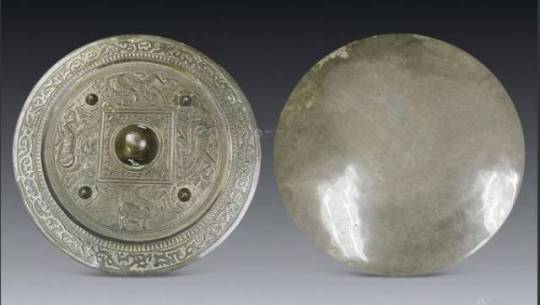Text
40K notes
·
View notes
Text
Chinese Magic Mirror (透光鏡)
The Chinese "Magic Mirror" (透光镜, tòu guāng jìng) traces back to at least the fifth century, although their existence during the Han dynasty as earliest as the second century has been claimed. The mirrors were made out of solid bronze and the front was polished so it could be used as a mirror, while the back has a design cast in the bronze, or other decoration; when sunlight or other bright light shines onto the mirror, the mirror appears to become transparent, if that light is reflected from the mirror onto a wall then the pattern on the back of the mirror is projected onto the wall.

In about 800 AD, during the Tang dynasty, a book entitled Record of Ancient Mirrors described the method of crafting solid bronze mirrors with decorations, written characters, or patterns on the reverse side that could cast these in a reflection on a nearby surface as light struck the front polished side of the mirror; due to this seemingly transparent effect, they were called "light-penetration mirrors". This Tang-era book was lost over the centuries, but magic mirrors were described in the Dream Pool Essays by Shen Kuo who owned three of them as family heirlooms.
2 notes
·
View notes
Text
The Four Cardinal Principles
The Four Cardinal Principles are a set of Legalist, and later Confucian (Ruism), foundational principles of morality referred to as the fundamental principles of conduct, or four social bonds. The Four Cardinal Principles are propriety (禮), righteousness (義), integrity (廉) and shame (恥).
They are derived from the Legalist text Guanzi attributed to the Qi philosopher Guan Zhong, although it is unlikely he was the actual author.

The Four Cardinal Principles can be understood as the following:
Lǐ (禮) - the rites and rituals, referring to the major Confucian duties such as ancestor worship and familial duties including all manner of ritualised cultural life in order to shape one's thinking and reinforce moral character.
Yì (義) - righteousness, refering to both correct conduct and the rejection of improper behaviour and dishonour including filial piety and correct social order.
Lián (廉) - integrity, referring to always being 'upright' in one's behaviour.
Chǐ (恥) - shame, referring to the appropriate response one should feel towards inappropriate behaviour; it is considered one of the means by which individuals judge right from wrong allowing for self-improvement. In some renderings of the principles the concept of chi is replaced with honour (耻).
0 notes
Text
The Four Gentlemen (四君子)
The Four Gentlemen (四君子, Sì Jūnzǐ) is a collective term and recurring theme in Chinese art refering to four plants each of them representing a different season with the plum blossom representing winter, the orchid representing spring, the bamboo representing summer and the chrysanthemum representing autumn; the four are used to depict the unfolding of the seasons through the year.
The term compares the four plants to Confucian jūn zǐ (君子), or "gentlemen" due to their long history as symbols of traditional Chinese virtues, such as uprightness, purity, humility and perseverance despite harsh conditions.

They are commonly depicted in bird-and-flower paintings, a broad category of classical Chinese art and they are particularly popular subjects for ink wash painting.
0 notes
Text
How to make quilts from the silk of the silkworm | source
11K notes
·
View notes
Text
The Qixi Festival (七夕)
The Qixi Festival is a Chinese festival celebrating the annual meeting of Zhinü and Niulang in Chinese mythology.
It is a celebration of romantic love and the festival is often described as the traditional Chinese equivalent of Valentine's Day. People celebrate the romantic legend of two lovers, Zhinü and Niulang, who were the weaver girl and the cowherder, respectively. The tale of The Cowherder and the Weaver Girl has been celebrated in the Qixi Festival since the Han dynasty. The earliest-known reference to this famous myth dates back to more than 2,600 years ago, which was told in a poem from the Classic of Poetry (詩經), one of the Four Books and Five Classics (四書五經) important in Ruism.

The festival is celebrated on the seventh day of the seventh lunisolar month on the Chinese lunisolar calendar.
0 notes
Text
The Four Arts (四藝)


Qin (琴) and Qi (棋)


Shu (書) and Hua (畫)
The four arts (四藝, siyi) were the four main academic and artistic talents required of the aristocratic ancient Chinese scholar-gentleman. They were the mastery of the qin (the stringed instrument the guqin, 琴), qi (the strategy game of Go, 棋), shu (Chinese calligraphy, 書) and hua (Chinese painting, 畫), and are also referred to by listing all four successivly: 琴棋書畫; qínqíshūhuà. [source]
0 notes